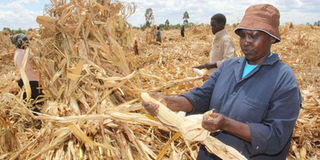Crop insurance can improve food security in Africa

Hellen Yego and her workers harvest maize at Moiben in Uasin Gishu County on October 15, 2015. Agriculture has always depended on the weather but climate change is making growing cycles more unpredictable. PHOTO | FILE | NATION MEDIA GROUP
What you need to know:
- Africa’s 50 million smallholder farmers, who rely on rain-fed crops to feed their families, are feeling effects of climate change first.
For families who live season to season, a bad weather year can mean months of hunger until the next harvest.
One proven tool to increase farmers’ resilience is crop insurance, which helps them to weather poor harvests and adapt to a changing climate.
Our food security depends on reliable harvests from smallholder farmers but erratic weather is making their job increasingly risky, with droughts cutting into harvests across Malawi, Rwanda, Tanzania and Zambia this year.
Governments must secure the livelihoods of farmers. One proven tool to increase farmers’ resilience is crop insurance, which helps them to weather poor harvests and adapt to a changing climate. But few insurers want to enter the market, making government support — like the Kenya Agriculture Insurance Programme (KAIP) — critical.
PRESSURE
Agriculture has always depended on the weather but climate change is making growing cycles more unpredictable. Africa’s 50 million smallholder farmers, who rely on rain-fed crops to feed their families, are feeling these changes first. For families who live season to season, a bad weather year can mean months of hunger until the next harvest.
In the short term, crop insurance can help to reduce hunger. When weather harms their crops, farmers get reimbursed for a portion of their upfront investment in seeds and fertiliser, easing the immediate financial pressure of a poor harvest.
RESILIENCE
In the long term, insurance can increase resilience. Farmers who purchase hybrid seeds suited to their local climate reliably harvest more food. But many farmers are, understandably, nervous to spend money on high-quality seed if they fear a bad year.
When farmers are confident of crop insurance coverage, they are more willing to try modern farming methods — a key to bigger harvests.
INCENTIVE
The idea is simple but the challenge is scale. Insuring 50 farmers in a single village is risky, because they’re all likely to have similar harvests. But insuring 50,000 farmers in a bigger area means the risk is more evenly spread, making it a better bet for insurance companies and more affordable for farmers.
Progressive policies can create an important incentive for agricultural insurance. In Kenya, the 2018/19 agricultural budget prioritises farmers’ resilience to “climate shocks” with a key focus on crop insurance for smallholders.
COMMERCIAL
That encourages insurers, who have traditionally focused on commercial farms, to add coverage options for the small-scale farms that produce 70 percent of Kenya’s maize. Rwanda is also developing a policy on crop insurance.
Subsidies can also help to build demand. Since 2016, KAIP has offered a 50 percent insurance subsidy for smallholders growing maize and wheat, one of the first large-scale schemes in Africa. In Uganda, the government offers a 70 percent subsidy for smallholder and commercial farmers, growing the insurance sector by 17 percent in 2017.
SENSITISATION
Finally, education is critical. Given low levels of awareness around crop insurance in the region, farmers may be hesitant to buy insurance. Sensitisation can help to build farmers’ confidence in the coverage.
Once governments have set the stage with smart policies and subsidies, the challenge is adoption. Governments can encourage adoption by tapping into existing networks for farmers rather than pursuing each farmer individually. For example, co-operatives, microfinance institutions and agro dealers can be encouraged to purchase insurance on behalf of a group of farmers.
Mr Ohaga is a senior communications associate, One Acre Fund; [email protected]





